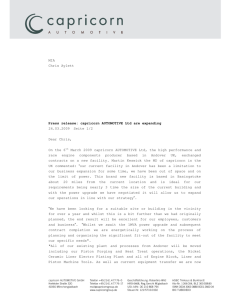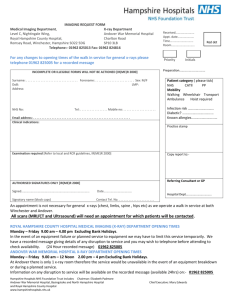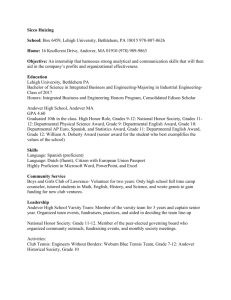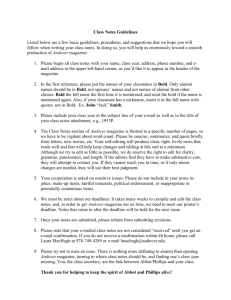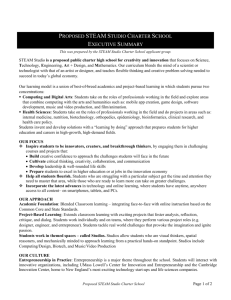The Medieval Citizen - Hampshire County Council
advertisement
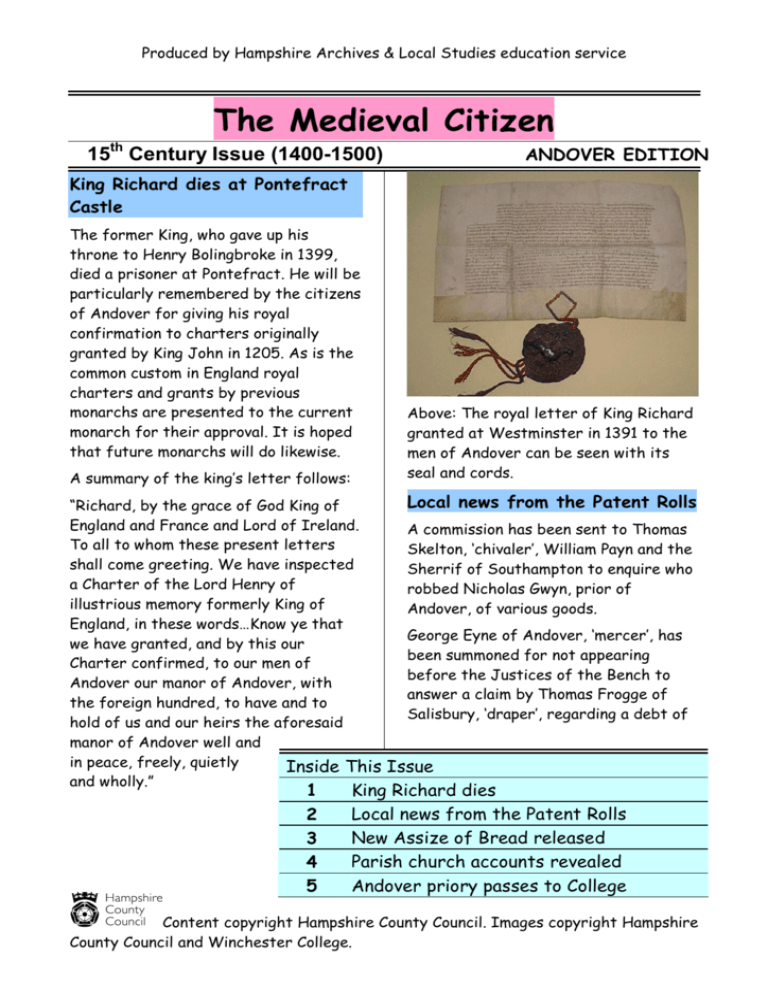
Produced by Hampshire Archives & Local Studies education service The Medieval Citizen 15th Century Issue (1400-1500) ANDOVER EDITION King Richard dies at Pontefract Castle The former King, who gave up his throne to Henry Bolingbroke in 1399, died a prisoner at Pontefract. He will be particularly remembered by the citizens of Andover for giving his royal confirmation to charters originally granted by King John in 1205. As is the common custom in England royal charters and grants by previous monarchs are presented to the current monarch for their approval. It is hoped that future monarchs will do likewise. A summary of the king’s letter follows: Above: The royal letter of King Richard granted at Westminster in 1391 to the men of Andover can be seen with its seal and cords. Local news from the Patent Rolls “Richard, by the grace of God King of England and France and Lord of Ireland. A commission has been sent to Thomas To all to whom these present letters Skelton, ‘chivaler’, William Payn and the shall come greeting. We have inspected Sherrif of Southampton to enquire who a Charter of the Lord Henry of robbed Nicholas Gwyn, prior of illustrious memory formerly King of Andover, of various goods. England, in these words…Know ye that George Eyne of Andover, ‘mercer’, has we have granted, and by this our been summoned for not appearing Charter confirmed, to our men of before the Justices of the Bench to Andover our manor of Andover, with answer a claim by Thomas Frogge of the foreign hundred, to have and to Salisbury, ‘draper’, regarding a debt of hold of us and our heirs the aforesaid manor of Andover well and in peace, freely, quietly Inside This Issue and wholly.” 1 2 3 4 5 King Richard dies Local news from the Patent Rolls New Assize of Bread released Parish church accounts revealed Andover priory passes to College Content copyright Hampshire County Council. Images copyright Hampshire County Council and Winchester College. Andover Medieval Citizen – 15th Century issue 40 shillings. William Ryche of Andover, ‘chapman’, has been summoned for not appearing to answer a claim by Robert Colwill, citizen and mercer of London, regarding a debt of £6. 2s. 7d. The Sherrif of Southampton is ordered to hold an election for a coroner instead of William Payn of Andover, who is insufficiently qualified. New Assize of Bread Poster A poster to be displayed at Andover Market has been released. Based on the Statute of Winchester, 1285, the price of a loaf of bread remains fixed but the weight of the loaf varies with the price of corn. Weights are expressed in money. For example, a pennyweight. The assize poster shows in the lefthand column symbols for the price of a quarter of wheat from 1 shilling to £1. In each of the next columns the cost of each type of loaf such as farthing and halfpenny loaves can be worked out. This means that the baker, the town’s officials and customers can see how much a loaf of bread should cost. A note at the foot of the poster states that the baker can claim allowance for 2 journeymen and 2 pages, bran, yeast and candles, as well as something for his tydoge (watch-dog). Above: a section of the Assize of Bread. Last Will & Testament of Thomas Dolling of Andover, 1497 In his will, written of course in Latin, Thomas Dolling has asked that his body be buried in the churchyard of the parish church of Andover. He left 4d to the Cathedral Church of Saint Swithin at Winchester, 4d to Andover church, 4d to the Gild of the Blessed Mary in Andover church, and 4d for a candle to burn before the High Cross in the church. He left his son John 20 sheep, his daughter Alice 20 sheep plus one quarter of his estate. The rest of his goods and estate after his debts are paid he left to his wife Isabella. Isabella and Nicholas Dredge to be executors of his will. For this Nicholas should receive 15d. 2 Andover Medieval Citizen – 15th Century issue Repairs were made to the wedding door Goods arriving at Andover on and porch. The church clock and bell carts, from Southampton were also repaired at great cost. Brokage Book John Hardyng carting towards Andover with one and a half centenae of garlic for John Doket. John Ber of Longstock carting to Andover with one pipe-load of iron and three barrels of white herrings for John Locket. Nicholas Gode carting to Andover with 15 cades of red herrings, two barrels of white herrings and five pieces of fruit for Richard Locket. Richard Donster carting to Andover with five sorts of fruit, five casks of red herrings of Thomas Selfester merchant of Winchester. Robert Maynsak provided a pint of oil and singing cakes and was paid 3d, whilst Agnes Maynsak was paid 18d for half a year’s washing of church vestments and 5d for making an amyss or cape lined with fur for use at Divine Service. William Clyfford, a bookbinder, was paid 5s 6d and a further 40 shillings for repairing a Breviary, Processional, Psalter and a Calendar. Bell-ringers were paid 6d and 8d when the King’s brother, the Duke of Clarence was here with his wife and daughter. Parish church accounts for 1471 The churchwarden’s accounts kept by Symond Herneman and William Plomer for Easter and Midsummer 1471 are available for parishioners to view. They include items paid for the upkeep of the parish church as well as regular payments from parish funds. The Paschal or Easter candle this year weighed two pounds and was made by Thomas Piper at a cost of seven shillings. A small ‘morrowmasse’ or sanctus bell was newly hung by John Helyer and several windows were repaired. Above: the churchwardens account book for Andover parish church. The original cost of the book was 12d paid to William Clyfford. 1 shilling and 4d was spent on washing and shearing the church sheep which keep the grass short in the churchyard. 3 Andover Medieval Citizen – 15th Century issue St Mary’s Priory, Andover Passes to Winchester College On September 1, 1413, prior Nicholas Gwyn signed over the Priory of Andover to the Warden and Scholars of Winchester College for the sum of 52 marks per year for the rest of prior Gwyn’s life. A handsome pension indeed. St Mary’s Priory was one of the alien or foreign priories endowed by William the Conqueror, who gave the church of Andover to the monks of St. Florence in Anjou. Confirmation of this grant was given by King Edward the second in June 1315 following a dispute in the local courts between Aluric, the reeve of Andover, and the monks of St. Florence. Part of this beautiful document with its illuminated letter E for Edward can be seen below, and is now owned along with all of the priory’s other ancient documents by the College. More Resources Available If you would like to find out more about life in Hampshire there are other resources available from Hampshire Archives & Local Studies website. http://www3.hants.gov.uk/archives/arc hive-education/online-resources.htm Above: photograph of a seal matrix belonging to the Austin Friars, or friars-hermits of the Convent of St Augustine, Winchester. Made of bronze, the matrix features two figures: Virgin and Child, and a male figure. Around the outside of the matrix is the inscription: S[igillum] P[ri]or[is] Ord[inis] Fr[atru]m Herem[itorum] S[an]cti Augustini Wynton. Fragments of red and green coloured wax can still be seen on the matrix showing that it had been used to create seals in the past. © Winchester College 4
